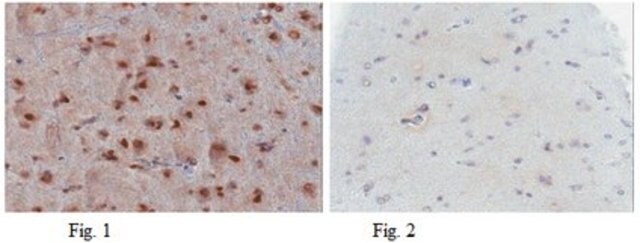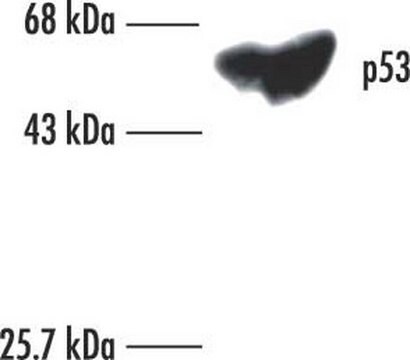おすすめの製品
由来生物
mouse
品質水準
抗体製品の状態
purified antibody
抗体製品タイプ
primary antibodies
クローン
PAb240, monoclonal
フォーム
lyophilized
含まれません
preservative
交差性
hamster, rat, mouse, bovine, chicken, human
以下との反応禁止
Xenopus
メーカー/製品名
Calbiochem®
保管条件
OK to freeze
アイソタイプ
IgG1
輸送温度
ambient
保管温度
2-8°C
ターゲットの翻訳後修飾
unmodified
遺伝子情報
human ... TP53(7157)
詳細
Purified mouse monoclonal antibody generated by immunizing BALB/c mice with the specified immunogen and fusing of splenocytes with SP2 mouse myeloma cells (see application references). Recognizes the ~53 kDa mutant p53 protein under non-denaturing conditions and both mutant and wild-type p53 under denaturing conditions.
Recognizes the ~53 kDa mutant p53 protein under non-denaturing conditions by immunoprecipitation, immunofluorescence, and flow cytometry. Recognizes both mutant and wild-type p53 by immunoblotting and paraffin sections under denaturing conditions.
This Anti-p53 (Ab-3) (Mutant) Mouse mAb (PAb240) is validated for use in FC, Frozen Sections, Gel Shift, Immunoblotting, IF, IP, Paraffin Sections for the detection of p53 (Ab-3) (Mutant).
免疫原
Epitope: within amino acids 213-217
Human
a recombinant protein consisting of amino acids 14-389 of p53 fused to β-galactosidase
アプリケーション
Flow Cytometry (1-20 µg/ml)
Frozen Sections (10 µg/ml)
Gel Shift (see comments)
Immunoblotting (5 µg/ml)
Immunofluorescence (1-20 µg/ml)
Immunoprecipitation (1 µg per sample)
Paraffin Sections (see application references)
Frozen Sections (10 µg/ml)
Gel Shift (see comments)
Immunoblotting (5 µg/ml)
Immunofluorescence (1-20 µg/ml)
Immunoprecipitation (1 µg per sample)
Paraffin Sections (see application references)
警告
Toxicity: Standard Handling (A)
物理的形状
Lyophilized from a volatile buffer, 100 µg BSA.
再構成
Reconstitute the lyophilized antibody with sterile PBS, pH 7.4, or sterile 20 mM Tris-saline (20 mM Tris containing 0.15 M NaCl), pH 7.4, to yield a final concentration of 100 µg/ml. Lyophilized antibodies should be reconstituted at 4°C with occasional gentle mixing for at least 2 h. Following reconstitution, refrigerate (4°C) for short-term storage or aliquot and freeze (-20°C) for long-term storage with 0.1% azide
アナリシスノート
Negative Control
SK-OV-3 cells
SK-OV-3 cells
Positive Control
A431, Hs27 (wild-type p53), or SK-BR-3 cells or breast carcinoma
A431, Hs27 (wild-type p53), or SK-BR-3 cells or breast carcinoma
その他情報
El-Deiry, W.S., et al. 1994. Cancer Res.54, 1169.
Greenblatt, M.S., et al. 1994. Cancer Res.54, 4855.
Barak, Y., et al. 1993. EMBO J.12, 461.
Kastan, M.B., et al. 1992. Cell71, 587.
Kuerbitz, S.J. 1992. Proc. Natl. Acad. Sci. USA89, 7491.
Lane, D.P. 1992. Nature358, 15.
Kastan, M.B., et al. 1991. Cancer Res.51, 6304.
Greenblatt, M.S., et al. 1994. Cancer Res.54, 4855.
Barak, Y., et al. 1993. EMBO J.12, 461.
Kastan, M.B., et al. 1992. Cell71, 587.
Kuerbitz, S.J. 1992. Proc. Natl. Acad. Sci. USA89, 7491.
Lane, D.P. 1992. Nature358, 15.
Kastan, M.B., et al. 1991. Cancer Res.51, 6304.
Under non-denaturing conditions (immunoprecipitation, immunofluorescence and frozen sections), p53 (Ab-3) does not bind to normal (wild-type) p53 protein; it recognizes an epitope exposed by activating mutations or denaturation. In denaturing protocols (immunoblotting and paraffin sections), p53 (Ab-3) will recognize both mutant and wild-type p53. Will not recognize to some p53 molecules with mutations in the RHSVV epitope, but will recognize TFIIIA, which has the RHSVV epitope. For gel shift assay, resuspend in 100 µl buffer. Antibodies should be titrated for optimal results in individual systems.
法的情報
CALBIOCHEM is a registered trademark of Merck KGaA, Darmstadt, Germany
適切な製品が見つかりませんか。
製品選択ツール.をお試しください
保管分類コード
11 - Combustible Solids
WGK
WGK 1
適用法令
試験研究用途を考慮した関連法令を主に挙げております。化学物質以外については、一部の情報のみ提供しています。 製品を安全かつ合法的に使用することは、使用者の義務です。最新情報により修正される場合があります。WEBの反映には時間を要することがあるため、適宜SDSをご参照ください。
Jan Code
OP29L-MG:
OP29L-100UG:
試験成績書(COA)
製品のロット番号・バッチ番号を入力して、試験成績書(COA) を検索できます。ロット番号・バッチ番号は、製品ラベルに「Lot」または「Batch」に続いて記載されています。
Esha Madan et al.
Nucleic acids research, 47(19), 10212-10234 (2019-09-21)
Chronic hypoxia is associated with a variety of physiological conditions such as rheumatoid arthritis, ischemia/reperfusion injury, stroke, diabetic vasculopathy, epilepsy and cancer. At the molecular level, hypoxia manifests its effects via activation of HIF-dependent transcription. On the other hand, an
ライフサイエンス、有機合成、材料科学、クロマトグラフィー、分析など、あらゆる分野の研究に経験のあるメンバーがおります。.
製品に関するお問い合わせはこちら(テクニカルサービス)








